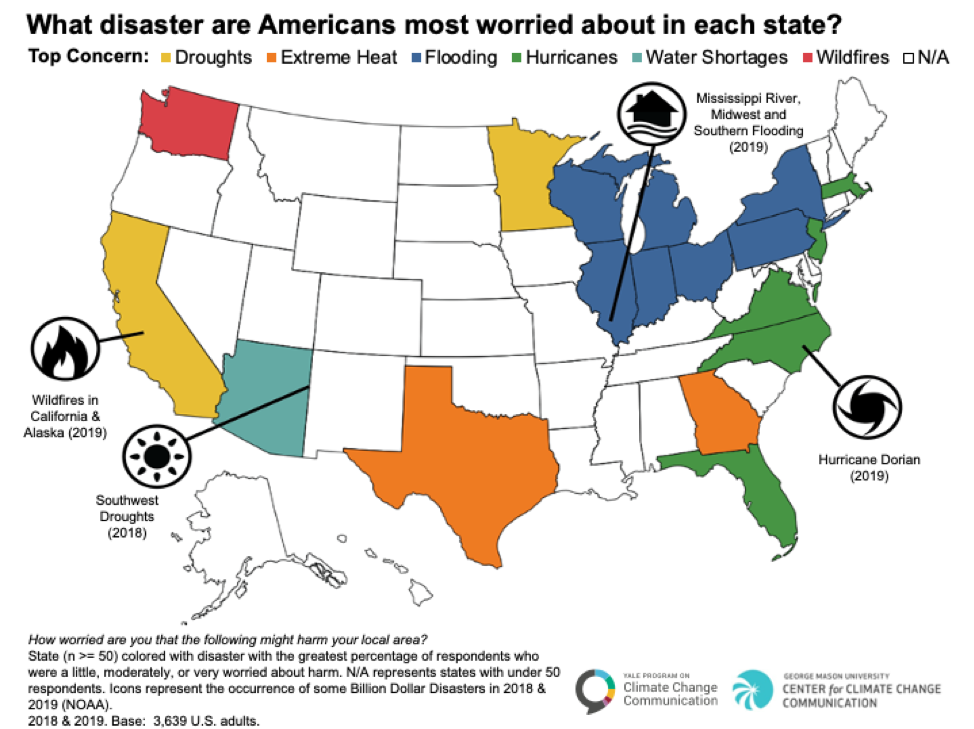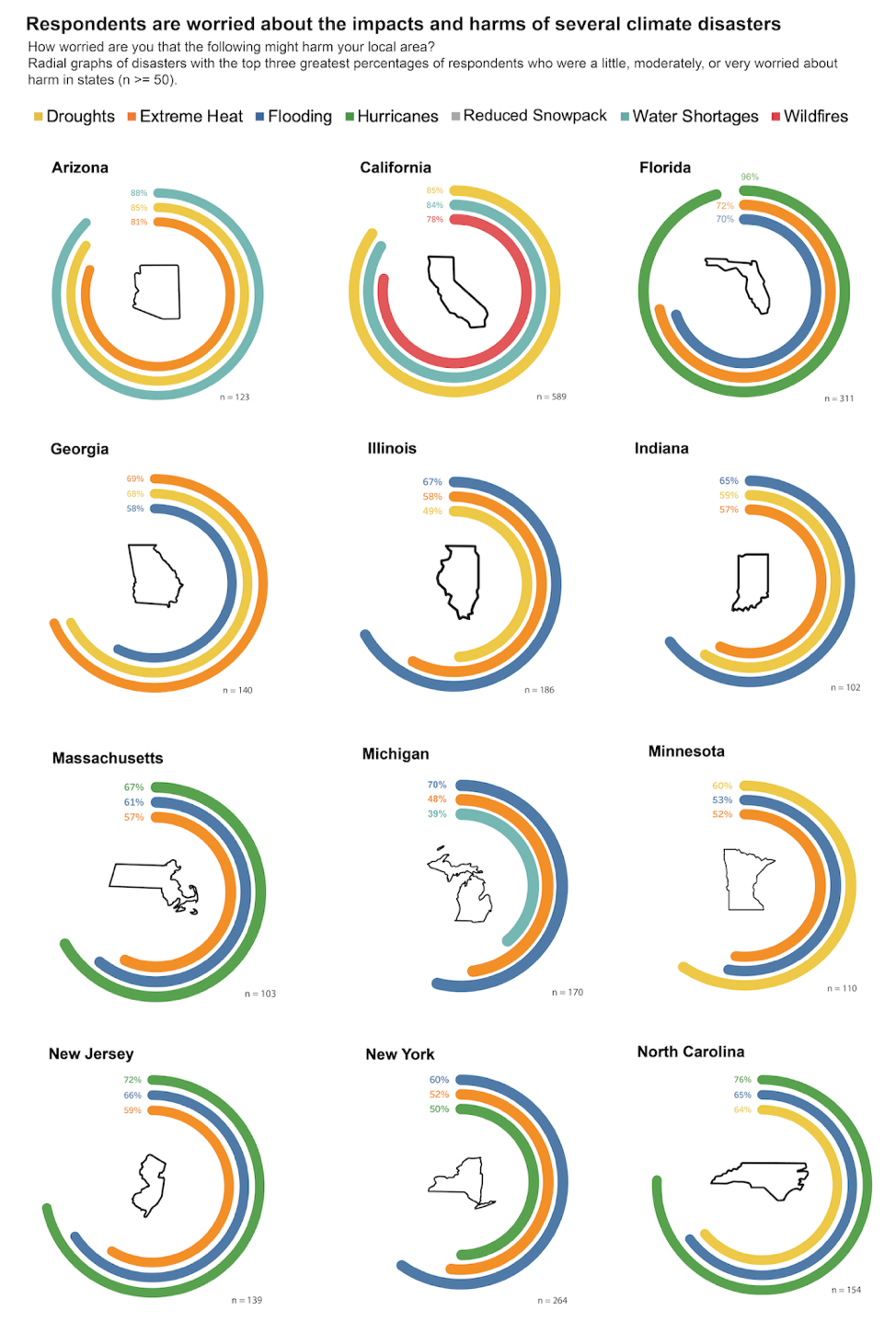Climate Note · Aug 24, 2020
How does the American public perceive climate disasters?
By Lauren Kim, Matthew Ballew, Karine Lacroix, Anthony Leiserowitz and Jennifer Marlon
Filed under: Climate Impacts and Beliefs & Attitudes
Extreme weather events are increasing in frequency and severity, and are projected to get worse as the climate warms. Over the past 10 years, the overall cost of damages from extreme weather and climate disasters in the U.S. has exceeded $800 billion. Many communities are still recovering from the impacts of prior disasters, while also having to prepare for new ones. With the arrival of a record-setting hurricane season, nationwide heatwaves, an “inland hurricane” or derecho in the Midwest, and massive wildfires in the West, 2020 reminds us of the importance of proactive disaster planning. How the public perceives these extreme weather events will be critical in the design of effective community preparedness strategies.
Each geographic region of the U.S. confronts a unique combination of extreme weather risks. How does the American public experience these unique weather shifts and do they attribute them to global warming? Do perceptions of risk differ geographically, and how is risk perception influenced by prior experiences of local disasters?
Research in the field of disaster risk perception has identified several factors that shape individual and societal concerns—from local geography and past experiences, to demographics. However, there are still gaps in our understanding of the links between public perceptions of extreme weather and climate change beliefs. Personal experience of disasters can at times influence climate change beliefs and motivate preventative measures. Extreme weather events can provide “teachable moments” to raise awareness and prompt action on climate change.
Using data from our Climate Change in the American Mind surveys from 2018 and 2019, we examine the public’s beliefs and risk perceptions about extreme weather. Specifically, we asked respondents to indicate whether or not they believed global warming is affecting the weather. For those who said yes, we asked “How much do you think global warming is affecting weather in the U.S.?”
We find that approximately two out of three Americans (64%) think that global warming is affecting weather in the United States “a lot” (32%), “some” (25%) or “a little” (7%).
We then asked “How worried are you that the following might harm your local area?”, including droughts, extreme heat, flooding, hurricanes, water shortages, and wildfires. The map below shows which of the six types of extreme weather events (indicated by different colors) had the highest proportion of worried individuals.
Heat-related events like wildfires, droughts, extreme heat, and water shortages were of greatest concern in more southern and western states (85% of respondents from California were most worried about droughts, 76% of respondents from Washington were most worried about wildfires). Residents worried most about flooding in the Midwest (54% of respondents from Michigan, 67% of respondents from Illinois) and about hurricanes in the East and Southeast regions of the US (76% of respondents from North Carolina, 68% of respondents from Virginia).
The icons on the map are examples of Billion Dollar Disaster Events, or incidents with losses exceeding $1 billion, that were consistent with public risk perceptions. The impacts of water shortages in the Southwest, flooding in the Midwest, and Hurricane Dorian correspond with the concerns expressed by respondents in those geographic regions. These data suggest that public perception of climate and weather risks can be influenced by local experience.
The map above only displays the disaster of greatest concern for respondents in selected states. However, Americans are often vulnerable to multiple risks at the same time. The radial maps below display residents’ top three climate and weather-related concerns by state.
For example, despite an intense wildfire season in California last year, droughts (85%) and water shortages (84%) were of concern to a greater proportion of California residents than wildfires (78%). Research has shown that increasing annual temperatures, decreasing precipitation rates, and other climate shifts are exacerbating wildfire conditions in California. While a majority (69%) of California residents believe that global warming is increasing the severity of wildfires, it is unclear whether respondents see links between these three extreme weather events and global warming.
In contrast, other states like Florida show a clear top concern: hurricanes, with 96% of Floridians worried about hurricane impacts on their local area.
Explore the radial maps below of public risk perceptions across multiple states.
Despite the geographical differences, Americans understand that the risks presented by weather and climate disasters are here to stay. A majority (56%) believe that extreme weather poses a “High” or “Moderate risk” to their community over the next 10 years, while fewer (37%) think extreme weather poses either a “Low” risk (31%) or “No” risk (7%).
Especially amidst the COVID-19 pandemic, local communities must prepare for the co-occurrence of multiple disasters. According to the 2017 Fourth National Climate Assessment, this isn’t a far-off future—communities are already experiencing climate change impacts. Without immediate action, escalating climate impacts could overwhelm communities across the US. Importantly, effective preparedness must account for the differences in public risk perceptions as well as the different impacts of extreme weather events.




